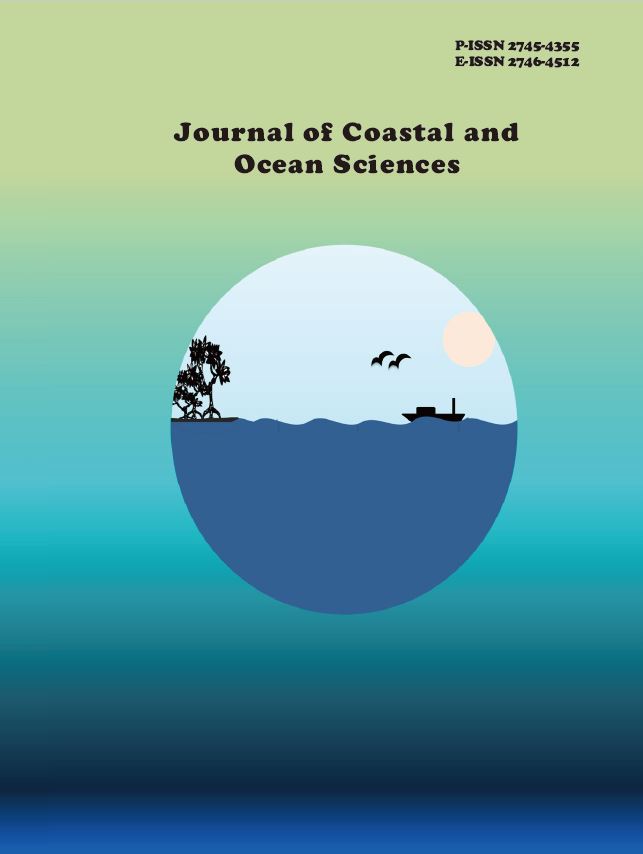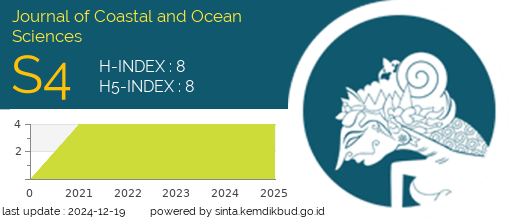Marine Debris Composition and Abundance: A Case Study of Selected Coastlines in Ujong Karang, Meulaboh, West Aceh
DOI:
https://doi.org/10.31258/jocos.5.1.1-6Keywords:
West Aceh, Marine Litter, Composition, AbundanceAbstract
Marine debris has become an increasing environmental threat in the world. West Aceh's coast is designated for tourism and fishing activities. This study determines the composition, characteristics, and abundance of waste on two selected beaches with economic activities for fishing (daily activities of coastal communities) and tourism activities. Garbage collection was carried out on two beaches on the coast of Johan Pahlawan District, West Aceh Regency, namely Pasar Baro Beach and Ujung Karang Beach. Pasar Baro Beach and Ujung Karang Beach were chosen because they are near fish market activities and recreational beaches, respectively. Determination of the sampling area by distance, from the low tide line to the first vegetation or concrete on the beach. The sampling length was measured using a 100 m roll meter parallel to the coastline. The results showed that the total weight (%) and frequency of waste per category were highest in the household category at Pasar Baro Beach. While at Ujung Karang Beach, the highest frequency of garbage is found in the variety of plastic drink bottles. The difference in abundance at the two stations is due to differences in visits and activities of the surrounding community. In addition, due to the lack of local cleaning efforts and facilities that could be more optimal, piles of garbage are still found along the coast
Downloads
References
Azwar, S.M.S. (2017). Pengelolaan sampah di Kabupaten Aceh Barat Provinsi Aceh. Universitas Gadjah Mada.
Barnes, D.K.A., Galgani, F., Thompson, R.C., Barlaz, M. (2009). Accumulation and fragmentation of plastic debris in global environments. Biological Sciences, 364(1526): 1985–1998.
Cole, M., Lindeque, P., Halsband, C., Galloway, T.S. (2011). Microplastics as contaminants in the marine environment: A review. Marine Pollution Bulletin, 62(12): 2588–2597.
Duhec, A.V., Jeanne, R.F., Maximenko, N., Hafner, J. (2015). Composition and potential origin of marine debris stranded in the Western Indian Ocean on remote Alphonse Island, Seychelles. Marine Pollution Bulletin, 96(1–2): 76–86.
Fruergaard, M., Laursen, S.N., Larsen, M.N., Posth, N.R., Niebe, K.B., Bentzon-Tarp, A., Svenningsen, S.K., Acevedo, N.L.I., Trinh, B.S., Tran-Thi, P.T., Doan-Nhu, H., Nguyen-Ngoc, L., Andersen, T.J. (2023). Abundance and sources of plastic debris on beaches in a plastic hotspot, Nha Trang, Vietnam. Marine Pollution Bulletin, 186: 114394.
Jambeck, J.R., Geyer, R., Wilcox, C., Siegler, T.R., Perryman, M., Andrady, A., Narayan, R., Law, K.L. (2015). Plastic waste inputs from land into the ocean. Science, 347(6223): 768–771.
Jang, Y.C., Ranatunga, R.R.M.K.P., Mok, J.Y., Kim, K.S., Hong, S.Y., Choi, Y.R., Gunasekara, A.J.M. (2018). Composition and abundance of marine debris stranded on the beaches of Sri Lanka, Results from the first island-wide survey. Marine Pollution Bulletin, 128: 126–131.
Khairunnisa, A. K., Fauziah, S.H., Agamuthu, P. (2012). Marine debris composition and abundance: A case study of selected beaches in Port Dickson, Malaysia. Aquatic Ecosystem Health & Management, 15(3): 279–286.
Kusumawati, I., Mita, S., Inseun, S.Y. (2018). Identifikasi komposisi sampah laut di Pesisir Aceh Barat. Jurnal Perikanan Tropis, 5(1).
Lestari, P., Trihadiningrum, Y. (2019). The impact of improper solid waste management on plastic pollution in the Indonesian coast and marine environment. Marine Pollution Bulletin, 149: 110505.
Lithner, D., Larsson, A., Dave, G. (2011). Environmental and health hazard ranking and assessment of plastic polymers based on chemical composition. Science of The Total Environment, 409(18): 3309–3324.
Mishra, P., Kaviarasan, T., Sambandam, M., Dhineka, K., Murthy, M.V.R., Iyengar, G., Singh, J., Ravichandran, M. (2023). Assessment of national beach litter composition, sources, and management along the Indian coast: a citizen science approach. Marine Pollution Bulletin, 186: 114405.
Rochman, C.M., Browne, M.A., Halpern, B.S., Hentschel, B.T., Hoh, E., Karapanagioti, H.K., Rios-Mendoza, L.M., Takada, H., Teh, S., Thompson, R.C. (2013). Classify plastic waste as hazardous. Nature, 494(7436): 169–171.
Ryan, P.G. (2015). Does size and buoyancy affect the long-distance transport of floating debris? Environmental Research Letters, 10(8): 084019.
Setiawan, A.D.C.D.S., Nugroho, S. (2022). Kecamatan Muara Badak dihubungkan dengan tingkat. Teknik Lingkungan, 6(1): 53–57.
Suaria, G., Melinte-Dobrinescu, M.C., Ion, G., Aliani, S. (2015). First observations on the abundance and composition of floating debris in the North-western Black Sea. Marine Environmental Research, 107: 45–49.
Thiel, M., Hinojosa, I.A., Miranda, L., Pantoja, J.F., Rivadeneira, M.M., Vásquez, N. (2013). Anthropogenic marine debris in the coastal environment: A multi-year comparison between coastal waters and local shores. Marine Pollution Bulletin, 71(1–2): 307–316.
Wang, M.H., He, Y., Sen, B. (2019). Research and management of plastic pollution in coastal environments of China. Environmental Pollution, 248: 898–905
Yulianita, Y., Mursyidin, M., Siregar, W.M. (2021). Analisis pelaksanaan pengelolaan sampah di Kabupaten Aceh Barat. Journal of Social and Policy Issues, 22–27.






